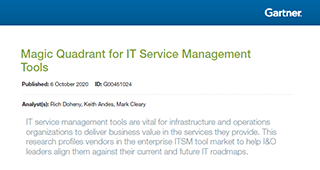| |
As an IT service management provider, customers frequently ask about the various approaches to IT Support and how they can be used to organize help desks and service desks. In this article, we’ll explore:
- The role of technical support
- IT support levels
- Tier 0 Support (L0)
- Tier 1 Support (L1)
- Tier 2 Support (L2)
- Tier 3 Support (L3)
- Tier 4 Support (L4)
- Trends
- The necessity of support
- Setup tips
- And more!
The role of technical support
Technical support is a service that supports users of technology products or services. Technical support is also known as IT support, help desk, or service desk. In contrast to traditional training, technical support typically focuses on helping with a specific user problem or issue.
Technical support often contributes to or supports a company’s overall customer service philosophy, so the team or department may straddle the technical world of IT and the practical side of customer service.
Technical support may be comprised of a single employee for small companies or may include many departments and workers. For example, a large company like BMC often has two types of teams:
- An internal IT support team that helps employees when they are dealing with a technical problem.
- An external-facing support team helps customers and users of BMC’s systems.
Technical support can be delivered in a variety of ways, depending on the support level or tier, including by phone, email, live chat or video, chatbots, online tutorials and how-to’s, message boards, and other logging tools. Popular third-party tools for help desk support include Zendesk, Salesforce, and BMC Helix, among many others.
(Understand the differences between customer service & technical support.)
Transform your IT Service Management with BMC Helix ITSM. ›
IT support levels (tiers)
The terms “support levels” and “support tiers” are phrases used interchangeably within IT organizations.
Structuring your IT support around levels or tiers is useful for several reasons:
- Strategically addressing customer needs
- Creating a positive customer experience
- Quickly resolving small or easy-to-manage issues
- Establishing a timeline and protocol for harder-to-solve problems
- Increasing employee satisfaction
- Improving employee training, upward mobility, and retention
- Obtaining feedback and suggestions for product development

With some variations, a typical IT Support infrastructure is usually organized around the following support tiers:
| IT Support Level | Function | ||
| Tier 0 | Self-help and user-retrieved information |
|
|
| Tier 1 | Basic help desk resolution and service desk delivery |
|
|
| Tier 2 | In-depth technical support |
|
|
| Tier 3 | Expert product and service support |
|
|
| Tier 4 | Outside support for problems not supported by the organization |
|
|
Tier 0 support (L0)
What is a level 0 help desk?
Level 0 or L0 support is sometimes called tier 0 of self-service support for users of IT systems, apps, or websites. It is often used as the first line of help in customer service or user support, and aims to help people solve problems without human assistance. The now-obsolete printed user manual has largely been replaced by digital resources and by automated interfaces. AI-powered L0 support, or tier 0 support, is evolving into a virtual help desk function that facilitates user-retrieved information for problem solving.
What does level 0 support mean?
Users retrieve support information from web and mobile pages or apps, including FAQs, detailed product and technical information, blog posts, manuals, and search functions. Users also use apps to access service catalogs, where they can request and receive services without involving the IT staff. Email, web forms, and social contact methods such as Twitter and LinkedIn are used to send questions and requests to upper support tiers or company personnel. Customer forums allow users to crowdsource solutions, usually without input from company personnel.
L0 support roles and responsibilities
- Creating tier 0 support capabilities requires technical and marketing resources to create, maintain, and update product information.
- An L0 support development team handles website and app creation.
- Tier 0 support moderators keep an eye on customer forums for insights, like common frustrations, that can be addressed when enhancing level 0 support.
Tier 1 support (L1)
What is a level 1 help desk?
Level 1 help desk, or tier 1 support, is the first level in which customers or users can make direct contact with a live person to solve their problems. The goal of effective L1 support is to quickly resolve a user issue, both for a better user experience and to keep costs down. If a tier 1 support representative is unable to resolve the issue, they need to be able to smoothly escalate it to a higher tier.
What does level 1 support mean?
L1 provides support for basic customer issues that need IT involvement, such as solving usage problems and fulfilling service desk requests. If no solution is available, tier 1 personnel escalate incidents to a higher tier.
L1 support roles and responsibilities
- Lower-level technical personnel, trained to solve known problems and to fulfill service requests by following scripts, typically provide tier 1 support.
- L1 support is often delivered by email, websites, online chat, or social media.
- Like L0 help, tier 1 support is increasingly tech-enabled.
Tier 2 support (L2)
What is a level 2 help desk?
Tier 2, also called level 2 support, engages L2 staff with a higher level of expertise and deeper knowledge of apps, systems, and issues. Tier 2 support involves in-depth troubleshooting and time-intensive problem-solving or more complex issues that are less common.
What does level 2 support mean?
Experienced and knowledgeable technicians assess issues and provide solutions for problems that cannot be handled by tier 1. If no solution is available, tier 2 support escalates the incident to tier 3.
L2 support roles and responsibilities
- Providers of tier 2 support are highly trained, with significant experience and deep knowledge of the product or service.
- While they are not typically the engineers or programmers who designed and created the product, L2 support personnel can do advanced troubleshooting and go deep in diagnosing issues.
- L2 employees have strong customer service skills that resolve problems and provide a positive user experience.
Tier 3 support (L3)
What is a level 3 help desk?
The advanced help that is provided in tier 3 support, or a level 3 help desk, addresses complex issues that L0, L1, and L2 support teams failed to resolve. These L3 issues are relatively rare. Tier 3 support may involve multifaceted technical issues that require experts with extensive knowledge of the product or service to untangle and resolve.
What does level 3 support mean?
L3 support means access to the highest technical resources available for problem resolution or new feature creation. Tier 3 technicians attempt to duplicate the problem and define root causes, using product designs, code, or specifications. Once a cause is identified, the company decides whether to create a new fix, depending on the cause of the problem. New fixes are documented for use by tier 1 and tier 2 personnel.
L3 support roles and responsibilities
- Tier 3 support specialists are generally the most highly skilled product or service experts in your organization. They do not fill L3 support roles as a primary job function.
- Tier 3 support is provided by experts who may include the creators, chief architects, or engineers who created the product or service.
- L3 support often requires subject matter experts who can conduct an extensive root cause analysis to fully resolve an issue.
Tier 4 support (L4)
What is a level 4 help desk?
When your organization lacks the in-house expertise or sufficient resources to resolve serious issues, you may need to bring in tier 4 support. Level 4 support is typically provided by third parties—vendors, external suppliers, or specialist service providers with deep and specific expertise about a product, service, or technology. In many cases, such L4 expertise is proprietary and only available from a vendor.
What does level 4 support mean?
Level 4 support is contracted support for items provided by, but not directly serviced by, the organization, including printer support, vendor software support, machine maintenance, depot support, and other outsourced services. Problems or requests are forwarded to tier 4 support and monitored by the organization for implementation.
L4 support roles and responsibilities
- Your organization will typically access tier 4 support from vendor technical support engineers with access to the proprietary tools, resources, and expertise needed to resolve complex problems.
- In some cases, trained and licensed third-party consultants can provide L4 support.
- Many vendors also employ field technicians who can work directly with your team in tier 4 support roles.
- Tier 4 support preferred vendors and business partners, giving help and services for items provided by your company.
Many companies modify this template and combine support tiers according to their resources and philosophies. In some organizations, Tier 1 and Tier 2 functions are handled by the same personnel. Other companies may combine Tier 2 and Tier 3 functions, for example.
Another way to think about the tiers is as a timeline: the higher the tier a problem is escalated, the more time (and perhaps resources) it will take to solve. Your company can:
- Set time limits on tiers. For instance, if a Tier 1 problem takes more than 15 minutes, it is automatically elevated to Tier 2.
- Let IT support staff determine when to escalate a problem.
Gain intelligent self-service with BMC Helix Virtual Agent! ›
Trends for tiered technical support
Trends we’re seeing frequently in tiered technical support include:
- Automation and orchestration. Automating and orchestrating as much of technical support as possible increases efficiency and availability, while reducing incident queues. Chatbots and virtual assistants are examples of this.
- Self-service and knowledge management. If information is easily accessible in tier 0, customers can quickly find solutions without IT help, saving higher skilled resources for creating new solutions and troubleshooting difficult problems. This combines two practices that are here to stay: self-service portals and knowledge management.
- Live chats (not pre-scripted). At higher tiers, live chats continue to replace a significant portion of phone calls. Offering a live chat option to your customers may prompt them to seek help more quickly, which can promote the positive customer experience.
- Empowering lower tiers. Sometimes called a “shift-left” approach, organizations are pushing more problem-solving into lower tiers, empowering them to resolve more complex tasks.
- Cloud-based support platforms. These remote support platforms allow staff to help your users from anywhere, making it easier to staff 24/7 expertise.
- Expanded knowledge management. Organizations are investing in knowledge management systems that crowdsource and centralize expertise in systems that support staff can quickly access for answers.
- AI-powered support. Your reps can use AI to help them quickly find likely resolutions to issues. Your development team can use AI to analyze trends, needs, preferences, and common user issues to drive future improvements. AI is driving these and other trends in IT support.
Of course, as users of any product become savvier, your help desk agents need to keep up—both with your own product as well as with your competitors. With comprehensive internet access, knowledge is the baseline; today, it is personalized help and customer service that become the medium for positive experiences.
(Explore chatbots & virtual agents.)
Is tiered technical support necessary?
A case can be made against tiered technical support. Swarming support, including intelligent swarming, has proven to be a strong alternative to traditional tiered support.
Opponents of tiered support sometimes cite employee boredom—solving the same problems repeatedly—or customer frustration, especially when the user realizes she knows more about the product than the help desk rep who’s trying to “help” her.
Collaboration is an often proposed solution: the idea that a help desk ticket is assigned to a specific individual or group who either resolves the issue directly or shepherds the ticket (and its user) through the support system. This can help support staff learn other areas of the company and ensures that customers feel better cared for.
A collaborative approach still relies on delineation around who can solve which problems or which teams are responsible for tickets, while others are there to assist with the help process as needed.
Setting up tiered technical support
Establishing or making changes to your technical support team can be overwhelming, especially as your company grows.
Developing a structure is the first step. Start with identifying your needs and circumstances. For example, a software company’s users will likely have a lot of technical issues whereas a service or retail company will have monetary or other issues. Using the tiers template above, determine what sorts of topics and issues might fit into each tier. Note that some companies use fewer tiers than the five levels (0 through 4) listed above. If you only have enough staff to support three levels, that is a fine approach!
Once you’ve established your support structure, consider how you can continue to support your support staff, so they can continue to create positive customer experiences:
- Define top skills for support staff. This may include strong verbal and written communication, a technical expertise, empathy, good listening skills, and more.
- Define top skills for support managers. This may include goal setting, motivation, experience with change management and conflict management, strong communication, and hiring experience.
- Create opportunities for growth. This can include formal and informal trainings, mentorships, and ongoing education through web resources and readings.
Tiered IT support is greatly enhanced by ITSM and software products that automate many of the functions provided by each tier.
(Learn more about choosing ITSM tools.)
Additional resources
For related reading, check out these resources:
- BMC Service Management Blog
- Technical Support Engineer Role & Responsibilities
- Becoming Agile in Technical Support
- Service Desk Best Practices for Creating More Value
- TIPS Explained: Ticket, Incident, Problem, Service Request
- State of ITSM Today








